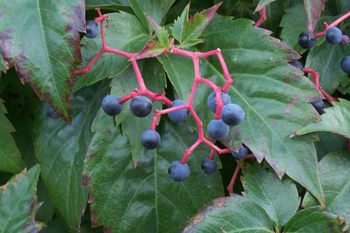Contents:
Common Names | Parts Usually Used | Plant(s) & Culture | Where Found | Medicinal Properties
Uses | Formulas or Dosages | Warning | Bibliography
Scientific Names

- Aristolochia serpentaria L.
- Aristolociaceae
- Birthwort family
Common Names
- Birthwort
- Pelican flower
- Red river snakeroot
- Sangree root
- Sangrel
- Serpentaria
- Snakeweed
- Texas snakeroot
- Thick birthwort
Parts Usually Used
Root
Back to Top
Description of Plant(s) and Culture
Virginia snakeroot is a delicate perennial plant; its fibrous, horizontal rootstock produces many thin roots, as well as a wavy stem that reaches 1-3 feet in height. The alternate thin, green leaves are ovate and cordate, tapering gradually to a point at the apex; strongly arrow-shaped. A few solitary purple flowers, calabash-pipelike, with an S-shaped calyx inflated at both ends, bloom on short, scaly branches near the bottom of the plant, often under the litter, during June and July.
Back to Top
Where Found
Grows in rich, dry woods of the eastern United States. Connecticut to Florida; Texas to Missouri, Ohio. Too rare to harvest.
Back to Top
Medicinal Properties
Anodyne, antispasmodic, diaphoretic, bitter tonic, nervine, stimulant
Back to Top
Uses
Small doses will stir a poor appetite, and promote proper digestion, but large doses will cause vomiting, diarrhea, vertigo, and other unpleasant effects. In proper doses it is said to stimulate blood circulation, reduce fever, stomachache, smallpox, scarlet fever, pneumonia, croup, flatulence, suppressed menses. The tea gargled for sore throats. At one time, this herb was perhaps the most highly valued of snakebite remedies, various other species of its genus also being used in different parts of the world for the same purpose. Native Americans treated snakebite by cutting into the bite and sucking out the poisonous venom, then applying the chewed root of the plant to the wound.
Back to Top
Formulas or Dosages
Infusion: steep 1 tsp. dried rootstock and roots in 1 cup boiling water. Take 1 tbsp. 3 to 6 times per day.
Tincture: a dose is from 1 to 20 drops, taken in cold water. Use with caution.
Back to Top
Warning
Virginia snakeroot contains an alkaloid which, in pure form, can paralyze the respiratory system. Use only small doses of the plant; and with medical supervision if possible. Too rare to harvest.
Back to Top
Bibliography
![]() American Folk Medicine
American Folk Medicine, by Clarence Meyer, Meyerbooks, publisher, PO Box 427, Glenwood, Illinois 60425, 1973
![]() Eastern/Central Medicinal Plants
Eastern/Central Medicinal Plants, by Steven Foster and James A. Duke., Houghton Mifflin Company, 215 Park Avenue South, New York, NY 10000
![]() The Herb Book
The Herb Book, by John Lust, Bantam Books, 666 Fifth Avenue, New York, NY. copyright 1974.
![]() Indian Herbalogy of North America
Indian Herbalogy of North America, by Alma R. Hutchens, Shambala Publications, Inc., Horticultural Hall, 300 Massachusetts Avenue, Boston, Massachusetts 02115, 1973
 The Rodale Herb Book: How to Use, Grow, and Buy Nature’s Miracle Plants (An Organic gardening and farming book)
The Rodale Herb Book: How to Use, Grow, and Buy Nature’s Miracle Plants (An Organic gardening and farming book), edited by William H. Hylton, Rodale Press, Inc. Emmaus, PA, 18049., 1974
